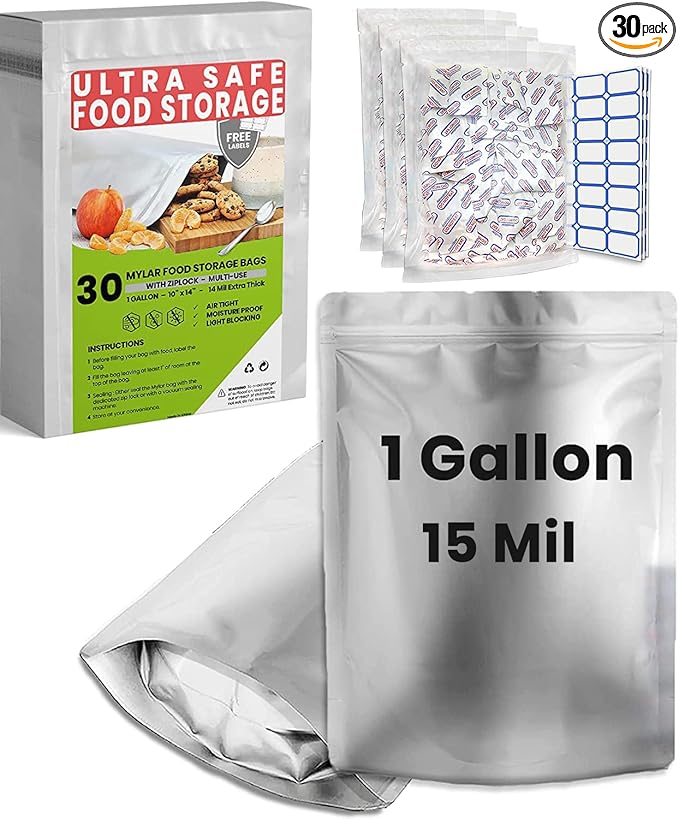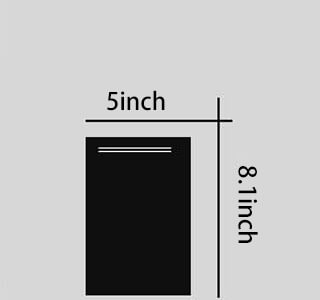Mylar bags are one of the most popular and effective solutions for long-term food storage and protection against environmental elements. Whether you’re looking to preserve dry goods for emergency preparedness or store perishable items for an extended period, Mylar bags offer a reliable and durable option. Their airtight and moisture-resistant properties make them ideal for protecting food, herbs, and other sensitive materials from oxygen, light, and humidity.
What Are Mylar Bags?
Mylar bags are made from a polyester film that has been laminated with a thin layer of metal, usually aluminum. This combination of materials creates a strong barrier that keeps out light, oxygen, moisture, and other contaminants. Mylar is often used for packaging because it has excellent durability and is highly resistant to tears and punctures, making it ideal for long-term storage.

Key Benefits of Using Mylar Bags
- Airtight Seal: Mylar bags create an airtight seal that helps prevent spoilage and oxidation, extending the shelf life of food products.
- Light Protection: The metallic layer of the bag blocks harmful light, preventing damage to light-sensitive products.
- Moisture Resistance: Mylar bags are moisture-resistant, making them perfect for keeping items dry in humid environments.
- Pest Protection: These bags also protect stored items from insects and rodents that can contaminate food supplies.
- Durability: Made of tough material, Mylar bags are highly resistant to tears and punctures, ensuring the contents stay safe.
How to Use Mylar Bags for Food Storage
1. Choose the Right Size of Mylar Bag
Mylar bags come in a variety of sizes, ranging from small pouches to large 5-gallon bags. The size you need will depend on the quantity of food or items you plan to store. Here are a few guidelines:
- Small Mylar Bags (1-2 quarts): Perfect for storing small amounts of spices, herbs, or snack-sized portions.
- Medium Mylar Bags (1 gallon): Ideal for grains, rice, beans, or freeze-dried meals.
- Large Mylar Bags (5 gallons): Best for bulk storage of grains, legumes, or flour, especially for long-term emergency food storage.

2. Prepare the Food for Storage
Before packing food into the Mylar bags, make sure the food is dry and free from moisture. Mylar bags are not designed for wet or fresh food storage, as moisture can cause spoilage. Ideal candidates for Mylar bag storage include:
- Rice, beans, and grains
- Flour and powdered goods
- Dehydrated vegetables and fruits
- Pasta and oats
- Freeze-dried meals
3. Add Oxygen Absorbers
To ensure maximum freshness and shelf life, it’s important to add oxygen absorbers to the Mylar bags before sealing them. Oxygen absorbers are small packets filled with iron powder, which absorbs and removes oxygen from the sealed bag, creating an oxygen-free environment that prevents spoilage.
Use the following guide to choose the correct size of oxygen absorber:
- 1-quart bag: Use a 100cc oxygen absorber.
- 1-gallon bag: Use a 300-500cc oxygen absorber.
- 5-gallon bag: Use a 2000cc oxygen absorber.
Make sure to quickly seal the bag after adding the absorber to prevent it from absorbing oxygen from the air before the bag is sealed.
4. Seal the Mylar Bag
After filling the Mylar bag with food and adding the oxygen absorber, it’s time to seal the bag. There are two common methods to seal Mylar bags:
- Heat Sealing: Use a household iron or a hair straightener to create a tight, secure seal. Place a flat board underneath the top of the bag, then run the iron or hair straightener along the edge to melt the material and seal the bag shut. Ensure the entire opening is sealed without gaps.
- Vacuum Sealing: If you have a vacuum sealer, you can use it to remove air and create a more compact seal. However, be cautious not to crush delicate food items like freeze-dried fruits.
Once the bag is sealed, check for any holes or incomplete seals by gently pressing on the bag to ensure no air escapes.
5. Store the Mylar Bags Properly
To maximize the longevity of the food inside, store the sealed Mylar bags in a cool, dark, and dry place. Avoid exposing the bags to direct sunlight or excessive heat, as it can weaken the material over time. For added protection, you can place the Mylar bags inside plastic or metal containers to prevent punctures or damage from rodents.
Tips for Using Mylar Bags
- Label the Bags: Always label the Mylar bags with the contents and the date of storage. This helps you keep track of what’s inside and when you stored it, so you can rotate your stock if needed.
- Double-Bag for Extra Protection: For extra safety, especially for items you plan to store for many years, consider double-bagging your food with a second layer of Mylar or placing them in a sturdy plastic container.
- Reuse Mylar Bags: In some cases, Mylar bags can be reused if they haven’t been punctured or torn. Simply clean and dry the bag thoroughly before resealing.
Applications Beyond Food Storage
Mylar bags are not just for long-term food storage. Here are a few other uses:
- Herb and Cannabis Storage: Mylar bags are frequently used in the cannabis industry to store and preserve herbs, as they protect the product from light and air exposure.
- Seed Storage: Gardeners use Mylar bags to store seeds for future planting, as the bags prevent moisture and oxygen from compromising seed viability.
- Document and Electronics Storage: Mylar bags are also useful for protecting important documents and electronics from moisture, dust, and environmental damage.
Conclusion
Whether you’re a prepper looking to build an emergency food supply, or simply want to extend the shelf life of your pantry items, Mylar bags offer a versatile and reliable storage solution. Their durable, airtight, and light-blocking properties make them ideal for preserving food and other sensitive materials for the long term.
At Colorful Packaging, we provide high-quality custom Mylar bags designed to meet the specific needs of your product, whether for food storage, herbal products, or industrial uses. Learn more about our customizable Mylar bags and how we can help your business succeed with quality packaging solutions.
